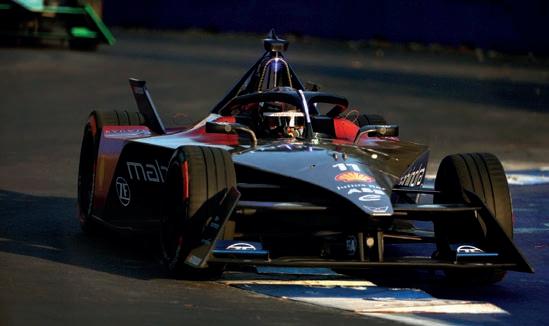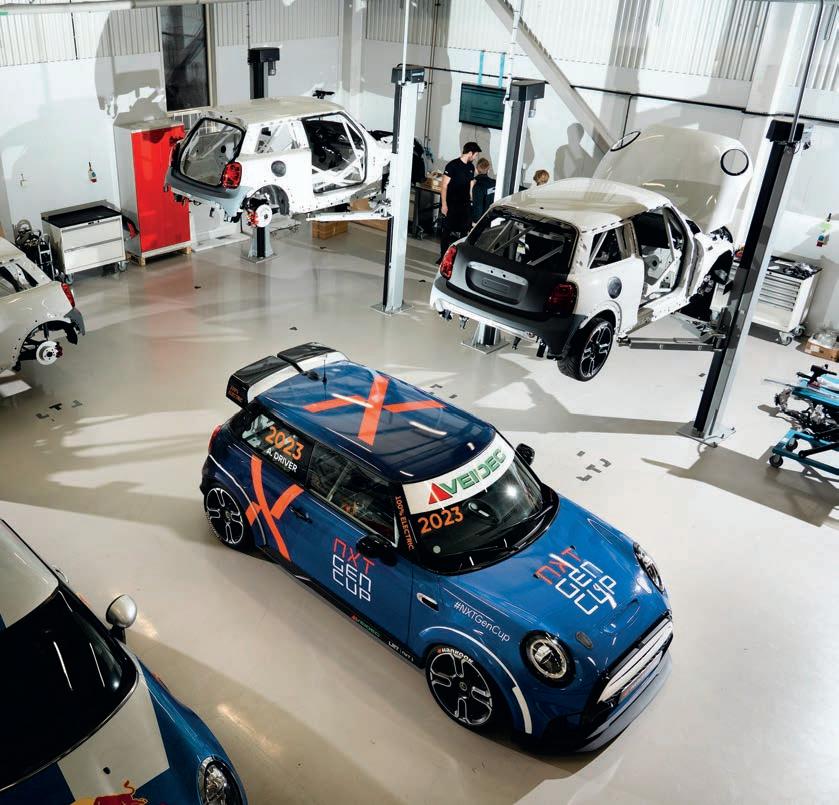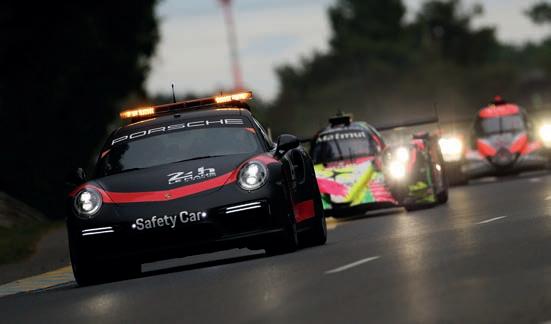
6 minute read
Hidden treasure?
Toyota’s updated GR010 has been on a diet in the latest upgrade package. Technical director, Pascal Vasselon, runs through the details
By ANDREW COTTON
Toyota has unveiled the second generation GR010 for the 2023 FIA World Endurance Championship. The car has been sympathetically updated, bearing in mind cost constraints and homologation limits, which have prevented Toyota Gazoo Racing (TGR) from going to town on the updates. Nevertheless, the team says its 2023 package is lighter and more serviceable.
The car retains the GR010 name as the chassis and engine are the same, although the latter has been developed for weight saving purposes. The regulations state there can be no improvement in power as it is limited and monitored, with torque sensors fitted to the driveshafts, and there can be little performance gain from aerodynamics due to the cars fitting into a narrow window of the lift / drag graph.
That’s not to say that there cannot be development. Aerodynamics can be improved to widen the operating window of the car and make it behave itself better in a broader range of conditions. The power band of the engine can also be improved, though any performance improvement is limited by the FIA’s ‘joker’ package.
Despite this, changes to the car were surprisingly few, given the original version was built to a set of regulations that has changed dramatically in the last three years. Originally, the minimum weight was 70kg higher than the car raced in 2021. The team could run a closed front differential, and the minimum deployment speed for hybrid power only applied in the wet. There was no cockpit-adjustable anti-roll bar option for the LMH cars either, but that has changed.
Racing overweight
Toyota was only partially able to address the change in weight before the car made its debut in 2021, but the diet sent the balance of the car to the rear, and anyway the team admits it has been racing overweight for two years, although refused to admit by how much. TGR will only say it lost much of the required weight but not how much.
The shift in balance prompted a change in tyre concept, to narrower front tyres and wider rear tyres for 2022, and the team is now locked into that regulation.
‘We fixed the main problem,’ says technical director, Pascal Vasselon, talking of the weight loss for the 2021 car. ‘Nevertheless, our car was still overweight, and was still significantly over the 1040kg, which is the minimum weight of an LMH four-wheel drive. Naturally, for this evolution, we made several weight saving steps where possible.’
This included revising the engine, gearbox and battery, notably areas around the mid-section and rear of the car, in a bid to balance it better and to make it more driveable in a wider range of conditions.
It was something of a surprise that very little was done to the front Motor Generator Unit, given the large changes made to the regulations in terms of how it can be used.
‘The change in deployment speed has massively reduced the benefit of the four- wheel-drive system, but it did not change anything in terms of sizing and weight because the front motor is still allowed to be 200kW,’ says Vasselon, referring to the rules that limit electrical power output.
‘The load cases are very similar to before, so there was no real reason to do weight saving here. The best weight saving would have been to drop the front motor, but this was not likely to happen.’
Minimal impact
There was little to be done in terms of either mechanical or aerodynamic efficiency at the front of the car. Aero is strictly limited by the Balance of Performance regulations, and so any change there would have minimal impact. Even mechanically there was little evolution at the front.
Despite some major changes to the regulations, the 2023 version of Toyota’s WEC car is remarkably similar to the 2021 version it replaces. Detail updates have largely focused on serviceability, along with a weight reduction at the rear
‘There were no grounds to do so based on the regulation evolution,’ confirms Vasselon. ‘Yes, we are constrained in terms of deployment speed, but the maximum power did not change. The differential had to change because we are not allowed to have large transfer rates, but this is a very minor hardware change that has no impact on weight.
Cost constraint
‘All we have done had an additional constraint – it had to be cost effective. Maybe we could have developed the front motor to achieve very slight efficiency improvements, but we didn’t do this, simply because the value for money was not there.’
The team was also constrained by the ‘joker’ system, which allows teams to introduce upgrades to its package within the five-year window of homologation. However, Vasselon was not willing to discuss how many jokers the team had used, as they are only valid for performance upgrades, not for reliability or cost upgrades.
The FIA works closely with the manufacturers on an individual basis to establish if an upgrade is solely performance, and then decides what penalty should be applied to the car in order to maintain the Balance of Performance.

‘You are allowed to implement additional performance factors when you can demonstrate a deficit,’ explains Vasselon.
‘Then you start counting the jokers. The joker parameters are very wide, but this is the regulation.’
Cooling off
The team has changed the aero for the car slightly, introducing smaller rear wing end plates and improving the cooling to the brakes through new vents at the front and rear. New dive planes have also been added to the front of the car, and the bodywork has been further developed to facilitate quick changes in the pit when needed.
The team has also revised the headlight layout to improve visibility at night.
‘In the past two seasons we have at times been struggling to adjust the brake cooling,’ confirms Vasselon. ‘Brake cooling is critical on a hybrid car because the level of braking energy is related to your recovery rate, which can be driven by other factors.
‘You have a viability of braking efficiency, which is much higher than on a purely mechanical non-hybrid car. At times we were struggling with brake cooling adjustments because our cooling concept was not easy to blank. Here, we went with a different cooling duct arrangement so we can add or remove blanking very easily.’
While the team focused on serviceability, the biggest cause for concern was the electronics in the car, which have caused delays at multiple races. Vasselon explains that this was more of a system issue of software than one of hardware, and the team are hopeful they have finally got on top of the problems.
Warming up
One of the biggest changes to the regulations for this year is the loss of tyre warmers in all classes in the WEC. Although this was common in other racing series, such as IMSA’s WeatherTech Sportscar championship, it’s new to the world championship and there has been resistance from some teams, saying it doesn’t help the environment if a car crashes on cold tyres. They also highlight the fact that qualifying has been increased from 10 to 15 minutes to help generate tyre temperature, increasing the time on track and burning more fuel. However, the FIA is trying to reduce the use of tyre warmers and supporters say it could add to the racing.
Tyre supplier, Michelin, offers the same product for both series, despite the fact the WEC tracks are traditionally more abrasive than those in the US. ‘The regulation is the same for everyone,’ says Vasselon diplomatically of the new rules. ‘Even if it sets a challenge to all the teams, we all know it’s a necessary challenge. There is no discussion on that. Probably the reason why the decision came so late was because we all had to make sure our tyre supplier was ready on time. We also have to consider that [not using tyre warmers is] more of a challenge in winter, especially for us when we are only testing in Europe for cost reasons. Europe is on the cold side in winter, and this makes it more difficult. We will pay attention to managing the cold tyres, but it will be less of a challenge to manage the cold tyres with 35 degrees on the ground at Sebring than at Paul Ricard with two degrees at night.’
The tyres themselves are also different compared to last year, and in the early races Porsche and Cadillac stole a march on the LMH manufacturers, having received theirs in December for a test at Daytona, and then having raced on them in the Daytona 24 hours in January.
That extra mileage in race conditions may help them on the low-grip circuit at Sebring, but the LMH manufacturers have tested on the European tracks, unlike Cadillac, which so far has mostly tested in the US.
‘The tyres definitely require some special handling,’ concludes Vasselon. ‘From the car set-up side, as well as the driver side, but I’m not going to elaborate on it.’










